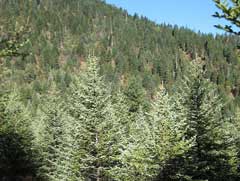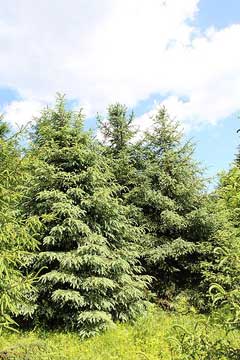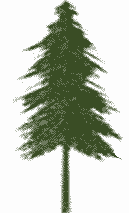 |
|
http://www.flickr.com/photos/rduta/ |
 |
| http://commons.wikimedia.org/wiki/User:Crusier |
Translate this page:
Summary
Physical Characteristics

 Picea asperata is an evergreen Tree growing to 40 m (131ft 3in) at a medium rate.
Picea asperata is an evergreen Tree growing to 40 m (131ft 3in) at a medium rate.
See above for USDA hardiness. It is hardy to UK zone 6 and is not frost tender. It is in leaf all year, in flower in April, and the seeds ripen from October to November. The species is monoecious (individual flowers are either male or female, but both sexes can be found on the same plant) and is pollinated by Wind.
Suitable for: light (sandy), medium (loamy) and heavy (clay) soils and can grow in nutritionally poor soil. Suitable pH: mildly acid and neutral soils and can grow in very acid soils.
It cannot grow in the shade. It prefers dry or moist soil. The plant can tolerates strong winds but not maritime exposure.
It cannot tolerate atmospheric pollution.
UK Hardiness Map
US Hardiness Map
Synonyms
Plant Habitats
Woodland Garden Canopy;
Edible Uses
Edible Parts: Flowers Inner bark Seed Shoots
Edible Uses: Tea
Young male catkins - raw or cooked. Used as a flavouring[172]. Immature female cones - cooked. The central portion, when roasted, is sweet and syrupy[172]. Inner bark - dried, ground into a powder and then used as a thickener in soups etc or added to cereals when making bread[172]. An emergency food when all else fails. Seed - raw. Too small and fiddly to be worthwhile unless you are desperate[172]. A refreshing tea, rich in vitamin C, can be made from the young shoot tips[172].
References More on Edible Uses
Medicinal Uses
Plants For A Future can not take any responsibility for any adverse effects from the use of plants. Always seek advice from a professional before using a plant medicinally.
Vitamin C
None known
References More on Medicinal Uses
The Bookshop: Edible Plant Books
Our Latest books on Perennial Plants For Food Forests and Permaculture Gardens in paperback or digital formats.

Edible Tropical Plants
Food Forest Plants for Hotter Conditions: 250+ Plants For Tropical Food Forests & Permaculture Gardens.
More

Edible Temperate Plants
Plants for Your Food Forest: 500 Plants for Temperate Food Forests & Permaculture Gardens.
More

More Books
PFAF have eight books available in paperback and digital formats. Browse the shop for more information.
Shop Now
Other Uses
Essential Resin Wood
Wood - soft, not strong. Used in general construction[46, 61]. It is also valued for its use in the pulp industry to make paper[171]. The timber is used for construction, aircraft, railway sleepers, furniture, and wood fiber[266]. The trunk is used for producing resin[266]. The roots, branches, and leaves are used for producing aromatic oils[266].
Special Uses
References More on Other Uses
Cultivation details
Likes abundant moisture at the roots, if grown in drier areas it must be given a deep moist soil[11]. Succeeds in wet cold and shallow soils but is not very wind-firm in shallow soils[1]. This species prefers a dry cold high mountain site[200]. Prefers a pH between 4 to 6[200]. Dislikes shade[200]. Tolerates poor peaty soils[200]. Intolerant of atmospheric pollution[11]. Resists wind exposure to some degree[200]. This species has been planted experimentally in Europe as a timber tree[50]. Growth of young trees is usually very slow due to damage by late spring frosts[11]. However, once trees get above 2 metres (which can take 10 years or more) growth increases and can be fairly rapid with an average of 30cm a year common[185]. In some upland areas, especially over granitic or other base-poor soils, growth rate and health have been seriously affected by aluminium poisoning induced by 'acid rain' pollution[200]. Trees should be planted into their permanent positions when they are quite small, between 30 and 90cm. Larger trees will check badly and hardly put on any growth for several years. This also badly affects root development and wind resistance[200]. Plants are strongly outbreeding, self-fertilized seed usually grows poorly[200]. They hybridize freely with other members of this genus[200].
References Carbon Farming Information and Carbon Sequestration Information
Temperature Converter
Type a value in the Celsius field to convert the value to Fahrenheit:
Fahrenheit:
The PFAF Bookshop
Plants For A Future have a number of books available in paperback and digital form. Book titles include Edible Plants, Edible Perennials, Edible Trees,Edible Shrubs, Woodland Gardening, and Temperate Food Forest Plants. Our new book is Food Forest Plants For Hotter Conditions (Tropical and Sub-Tropical).
Shop Now
Plant Propagation
Seed - stratification will probably improve germination so sow fresh seed in the autumn in a cold frame if possible[80]. Sow stored seed as early in the year as possible in a cold frame[78]. A position in light shade is probably best[78]. Seed should not be allowed to dry out and should be stored in a cool place[80]. Prick out the seedlings into individual pots when they are large enough to handle and grow them on in the greenhouse or cold frame for their first winter. They can be planted out into their permanent positions in early summer of the following year, or be placed in an outdoor nursery bed for a year or so to increase in size. They might need protection from spring frosts. Cuttings of semi-ripe terminal shoots, 5 - 8cm long, August in a frame. Protect from frost. Forms roots in the spring[78]. Cuttings of mature terminal shoots, 5 - 10cm long, September/October in a cold frame. Takes 12 months[78]. Cuttings of soft to semi-ripe wood, early summer in a frame. Slow but sure.
Other Names
If available other names are mentioned here
Native Range
TEMPERATE ASIA: China (Gansu Sheng, Ningxia Huizi Zizhiqu, Qinghai Sheng, Shaanxi Sheng, Sichuan Sheng)
Weed Potential
Right plant wrong place. We are currently updating this section.
Please note that a plant may be invasive in one area but may not in your area so it's worth checking.
Conservation Status
IUCN Red List of Threatened Plants Status :

Growth: S = slow M = medium F = fast. Soil: L = light (sandy) M = medium H = heavy (clay). pH: A = acid N = neutral B = basic (alkaline). Shade: F = full shade S = semi-shade N = no shade. Moisture: D = dry M = Moist We = wet Wa = water.
Now available:
Food Forest Plants for Mediterranean Conditions
350+ Perennial Plants For Mediterranean and Drier Food Forests and Permaculture Gardens.
[Paperback and eBook]
This is the third in Plants For A Future's series of plant guides for food forests tailored to
specific climate zones. Following volumes on temperate and tropical ecosystems, this book focuses
on species suited to Mediterranean conditions—regions with hot, dry summers and cool, wet winters,
often facing the added challenge of climate change.
Read More
Expert comment
Author
Mast.
Botanical References
11200266
Links / References
For a list of references used on this page please go here
Readers comment
| Add a comment |
|
If you have important information about this plant that may help other users please add a comment or link below. Only comments or links that are felt to be directly relevant to a plant will be included. If you think a comment/link or information contained on this page is inaccurate or misleading we would welcome your feedback at [email protected]. If you have questions about a plant please use the Forum on this website as we do not have the resources to answer questions ourselves.
* Please note: the comments by website users are not necessarily those held by PFAF and may give misleading or inaccurate information.
To leave a comment please Register or login here All comments need to be approved so will not appear immediately.
|
|